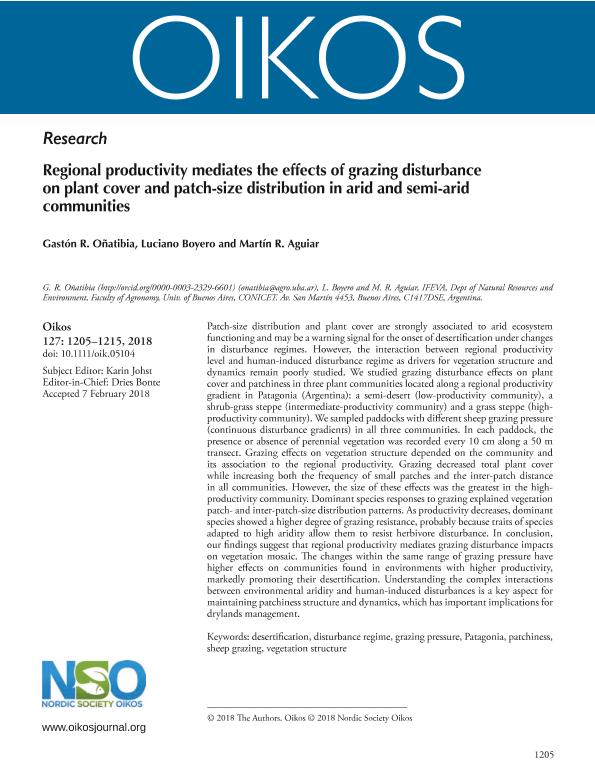Artículo
Regional productivity mediates the effects of grazing disturbance on plant cover and patch-size distribution in arid and semi-arid communities
Fecha de publicación:
08/2018
Editorial:
Wiley Blackwell Publishing, Inc
Revista:
Oikos
ISSN:
0030-1299
Idioma:
Inglés
Tipo de recurso:
Artículo publicado
Clasificación temática:
Resumen
Patch‐size distribution and plant cover are strongly associated to arid ecosystem functioning and may be a warning signal for the onset of desertification under changes in disturbance regimes. However, the interaction between regional productivity level and human‐induced disturbance regime as drivers for vegetation structure and dynamics remain poorly studied. We studied grazing disturbance effects on plant cover and patchiness in three plant communities located along a regional productivity gradient in Patagonia (Argentina): a semi‐desert (low‐productivity community), a shrub‐grass steppe (intermediate‐productivity community) and a grass steppe (high‐productivity community). We sampled paddocks with different sheep grazing pressure (continuous disturbance gradients) in all three communities. In each paddock, the presence or absence of perennial vegetation was recorded every 10 cm along a 50 m transect. Grazing effects on vegetation structure depended on the community and its association to the regional productivity. Grazing decreased total plant cover while increasing both the frequency of small patches and the inter‐patch distance in all communities. However, the size of these effects was the greatest in the high‐productivity community. Dominant species responses to grazing explained vegetation patch‐ and inter‐patch‐size distribution patterns. As productivity decreases, dominant species showed a higher degree of grazing resistance, probably because traits of species adapted to high aridity allow them to resist herbivore disturbance. In conclusion, our findings suggest that regional productivity mediates grazing disturbance impacts on vegetation mosaic. The changes within the same range of grazing pressure have higher effects on communities found in environments with higher productivity, markedly promoting their desertification. Understanding the complex interactions between environmental aridity and human‐induced disturbances is a key aspect for maintaining patchiness structure and dynamics, which has important implications for drylands management.
Archivos asociados
Licencia
Identificadores
Colecciones
Articulos(IFEVA)
Articulos de INST.D/INV.FISIOLOGICAS Y ECO.VINCULADAS A L/AGRIC
Articulos de INST.D/INV.FISIOLOGICAS Y ECO.VINCULADAS A L/AGRIC
Citación
Oñatibia, Gastón Rafael; Boyero, Luciano; Aguiar, Martin Roberto; Regional productivity mediates the effects of grazing disturbance on plant cover and patch-size distribution in arid and semi-arid communities; Wiley Blackwell Publishing, Inc; Oikos; 127; 8; 8-2018; 1205-1215
Compartir
Altmétricas




